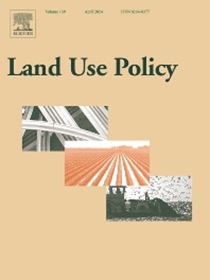Land tenure and conservation in agriculture: Evidence from United States farm-level data
IF 6
1区 社会学
Q1 ENVIRONMENTAL STUDIES
引用次数: 0
Abstract
The adoption of conservation practices on working farmland has proven effective in mitigating environmental externalities created by agricultural production. The widespread use of these practices, among other factors, depends on the private benefits and costs associated with them, as well as the timing of the outcomes. Around 40 % of all farmland acres in the U.S. are rented by operators who do not own them. In theory, renters facing tenure insecurity, higher discount rates, and shorter planning horizons may be less inclined to adopt conservation. In this paper, we empirically investigate whether the adoption of conservation tillage practices and cover crops differs among producers with different land tenure. Specifically, we use operation-level data from the Census of Agriculture to assess the effect of land tenure and several producer-level characteristics on conservation adoption. We find that owners adopt no-till practices at higher rates relative to renters, but the adoption rates of reduced-tillage and cover crops are, on average, higher among renters compared to owners. We show that these differences are most pronounced among small and medium-sized farms, and the impact of tenure becomes statistically insignificant in larger operations. Additionally, we find evidence that cash rental arrangements may positively influence conservation adoption among renters relative to share lease contracts. Our results have important implications for the design of conservation programs. Our findings do not fully support arguments suggesting that policies increasing the proportion of owner-operated cropland or incentivizing share-rental arrangements might increase the adoption of all conservation practices among producers, or that renters and owners should be treated differently from the policy perspective.
农业中的土地保有和保护:来自美国农场层面数据的证据
在耕作农田采取保育措施,已证明可有效减轻农业生产造成的环境外部性。除其他因素外,这些做法的广泛使用取决于与之相关的私人收益和成本,以及结果的时机。在美国,大约40% %的农田面积是由不拥有这些土地的经营者租用的。理论上,面临租赁权不安全、更高的贴现率和更短的规划期限的租房者可能不太倾向于采取保护措施。本文对不同土地权属生产者采用保护性耕作方式和覆盖作物是否存在差异进行了实证研究。具体来说,我们使用来自农业普查的操作层面数据来评估土地权属和几个生产者层面特征对保护采用的影响。我们发现,与租户相比,业主采用免耕做法的比例更高,但平均而言,租户采用免耕和覆盖作物的比例高于业主。我们表明,这些差异在中小型农场中最为明显,而在较大的农场中,权属的影响在统计上微不足道。此外,我们发现有证据表明,相对于共享租赁合同,现金租赁安排可能会积极影响租户的保护采用。我们的研究结果对保护项目的设计具有重要意义。我们的研究结果并不完全支持以下论点:增加业主经营农田比例的政策或激励共享租赁安排可能会增加生产者对所有保护措施的采用,或者从政策角度来看,应该区别对待租户和所有者。
本文章由计算机程序翻译,如有差异,请以英文原文为准。
求助全文
约1分钟内获得全文
求助全文
来源期刊

Land Use Policy
ENVIRONMENTAL STUDIES-
CiteScore
13.70
自引率
8.50%
发文量
553
期刊介绍:
Land Use Policy is an international and interdisciplinary journal concerned with the social, economic, political, legal, physical and planning aspects of urban and rural land use.
Land Use Policy examines issues in geography, agriculture, forestry, irrigation, environmental conservation, housing, urban development and transport in both developed and developing countries through major refereed articles and shorter viewpoint pieces.
 求助内容:
求助内容: 应助结果提醒方式:
应助结果提醒方式:


